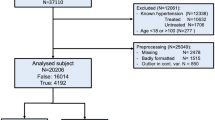Abstract
Hypertension is a major risk factor for cardiovascular diseases (CVD). Identifying the persons at these high risks plays an important role because it would save time and money before using any complex, invasive and/or expensive diagnostic methods. This task can be partly dealt with the help of advanced machine-learning methods. Specifically, a prediction model can be developed based on some indicator factors of the people at high risks which are easily-obtained, non-invasive and low-cost. This paper presents the first work towards predicting hypertension risks based on of the people in the Northwest region of Vietnam where hypertension rate is increasing. 2.509 samples were collected and classified into two levels of hypertension or no hypertension. We investigated and compared the performance of robust machine learning methods including single classifiers such as Naïve Bayes, MLP, Decision Tree, kNN and SVM; and ensemble classifiers such as bagging, boosting and voting methods, to generate mathematical models to predict the risk of hypertension disease. The experimental results showed that the best random forest model yielded 72.39% in the F1 score. This result was quite promising and can be applied in Vietnamese hospital nowadays.






Similar content being viewed by others
Notes
This dataset will be available to download at the publication time.
“Application and deployment of software system for integrating and connecting biomedical electronic devices and communication networks to support the monitoring of health and epidemiology in the Northwest region”, National research project funded by Ministry of Science and Technology.
References
Kupusinac A, Doroslovacki R, Malbaski D, Srdic B, Stokic E (2013) A primary estimation of the cardiometabolic risk by using artificial neural networks. Comput Biol Med 43(6):751–757
Luo ZY, Cui J, Hu XJ, Tu LP, Liu HD, Jiao W, Zeng LZ, Jing CC, Qiao LJ, Ma XM, Wang Y, Wang J, Pai CH, Qi Z, Zhang ZF, Xu JT (2018) A Study of Machine-Learning Classifiers for Hypertension Based on Radial Pulse Wave. BioMed Res Int 2018:12 (Article ID 2964816)
Lyon A, Mincholé A, Martínez JP, Laguna P, Rodriguez B (2018) Computational techniques for ECG analysis and interpretation in light of their contribution to medical advances. J R Soc Interface 15(138):20170821. https://doi.org/10.1098/rsif.2017.0821
Nguyen LL, Su S, Nguyen HT (2014) Neural network approach for non-invasive detection of hyperglycemia using electrocardiographic signals. Annu Int Conf IEEE Eng Med Biol Soc 2014:4475–4478. https://doi.org/10.1109/EMBC.2014.6944617
Santhanam P, Ahima RS (2019) Machine learning and blood pressure. J Clin Hypertens 21(11):1735–1737. https://doi.org/10.1111/jch.13700
Golino HF, Amaral LS, Duarte SF et al (2014) Predicting increased blood pressure using machine learning. J Obes 2014:637635
Pulido M, Melin P, Prado-Arechiga G (2019) Blood pressure classification using the method of the modular neural networks. Int J Hypertens 2019:7320365
Allen J, Murray A (1999) Modelling the relationship between peripheral blood pressure and blood volume pulses using linear and neural network system identification techniques. Physiol Meas 20(3):287–301
Ren Z, Rao B, Xie S et al (2020) A novel predicted model for hypertension based on a large cross-sectional study. Sci Rep 10:10615. https://doi.org/10.1038/s41598-020-64980-8
Sumathi B, Santhakumaran A (2011) Pre-diagnosis of hypertension using artificial neural network. Global J Comput Sci Technol 11(2)
Hoang VM, Tran QB, Vu THL, Nguyen TKN, Kim BG, Pham QN, Nguyen TL, Lai DT, Nakagawa J, Shin HR, Kim WJ, Riley L, Wadhwani C, Truong DBT, Tran DP (2019) Patterns of Raised Blood Pressure in Vietnam: Findings from the WHO STEPS Survey 2015. Int J Hypertens 2019:7 (Article ID 1219783)
Meiqari L, Essink D, Wright P, Scheele F (2019) Prevalence of Hypertension in Vietnam: A Systematic Review and Meta-Analysis. Asia Pac J Pub Health. 31(2):101–112
Nguyen MQ, Nguyen VMH (2020) Anthropometric Indexes for Predicting High Blood Pressure in Vietnamese Adults: A Cross-Sectional Study. Integr Blood Press Control 13:181–186. https://doi.org/10.2147/IBPC.S281996
Webb GI, Sammut C, Perlich C, Horvath T, Wrobel S, Korb KB, Noble WS, Leslie C, Lagoudakis MG, Quadrianto N, Buntine WL, Quadrianto N, Buntine WL, Getoor L, Namata G, Getoor L, Jiawei Han XJ, Ting J-A, Vijayakumar S, Schaal S (2011) Logistic regression. In: Sammut C, Webb GI, (eds) Encyclopedia of machine learning. Boston: Springer, p 631
Cortes C, Vapnik V (1995) Support vector machine. Mach Learn 20(3):273–297
Breiman L (2001) Random forests. Mach Learn 45(1):5–32
Chen T, He T, Benesty M, Khotilovich V, Tang Y (2015) Xgboost: extreme gradient boosting. R package version 04–2:1–4
Miao F, Fu N, Zhang YT et al (2017) A novel continuous blood pressure estimation approach based on data mining techniques. IEEE J Biomed Health Inform 21(6):1730–1740
Xiao H, Qasem A, Butlin M, Avolio A (2017) Estimation of aortic systolic blood pressure from radial systolic and diastolic blood pressures alone using artificial neural networks. J Hypertens 35(8):1577–1585
Falk CT (2003) Risk factors for coronary artery disease and the use of neural networks to predict the presence or absence of high blood pressure. BMC Genet 4(Suppl 1):S67
Quinlan JR (1999) Simplifying decision trees. Int J Hum Comput Stud 51(2):497–510
Acknowledgements
This research is funded by International School, Vietnam National University, Hanoi (VNU-IS) under project number CS.NNC/2021-08.
Author information
Authors and Affiliations
Corresponding author
Additional information
Publisher's note
Springer Nature remains neutral with regard to jurisdictional claims in published maps and institutional affiliations.
Rights and permissions
About this article
Cite this article
Oanh, T.T., Tung, N.T. Predicting Hypertension Based on Machine Learning Methods: A Case Study in Northwest Vietnam. Mobile Netw Appl 27, 2013–2023 (2022). https://doi.org/10.1007/s11036-022-01984-w
Accepted:
Published:
Issue Date:
DOI: https://doi.org/10.1007/s11036-022-01984-w




